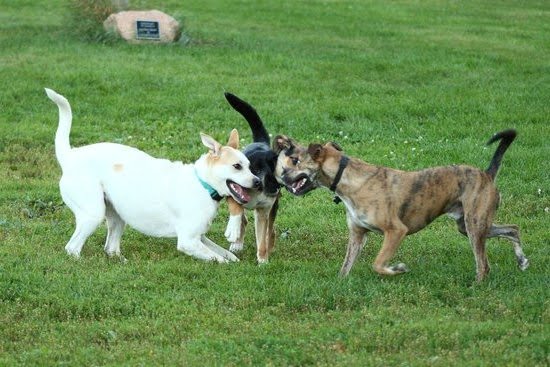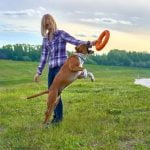Introduction
Training your dog not to charge other dogs can help keep your dog as well as other dogs safe from harm. Not only is it important for the safety of other animals, but it also teaches your pet that it’s not appropriate to chase or attack another animal. It will also make walks and trips to the park much less stressful for you and your pup. By teaching your dog how to interact properly with other pups, it’ll endear them to others who may be visiting or out walking their own pet.
To begin training, ensure that all interactions between your pup and other pets are in environments that promote positivity — places such as controlled and supervised puppy classes at a local park or vet clinic where everyone is calm and there are no distractions like squeaky toys or loud noises. Reward good behavior with positive reinforcement like treats and verbal praise whenever they look at an unfamiliar dog without getting overly excited or trying to rush up to them. If they do start charging another pup, shake a can full of coins near them or spray them with a water bottle mist as punishments but never shout at them as this may cause unwanted stress. If distractions like toys are around, take them away so that there’s no temptation for your pet get aggressive. Finally, practice obedience commands such as “Sit” regularly so the commands come naturally during moments when you need to prevent potential encounters with strange animals while out on a walk. With time and patience, you should have no trouble training your pup not to charge other dogs — beneficial all-round!
Assessing Your Dog’s Temperament and Breeding
When it comes to training your dog not to charge other dogs, it is important to be aware of your pet’s temperament and breed. Some breeds, such as terriers, are known for being more aggressive or prone to attacking. The size and age of the breed can also contribute to a dog’s temperament and behavior around other dogs. For example, larger breeds tend to be more dominant while smaller breeds may try to dominate but don’t have the same physical and verbal cues that larger dogs do. Knowing your dog’s breed and what kinds of behaviors are typical can help you be prepared in case your dog exhibits the tendency to charge other dogs.
It is also helpful to understand any past experiences that may have caused fear or aggression in your pet towards other dogs. It could include a history of negative interactions with large animals (such as horses) or perhaps with young puppies who have approached them suddenly. Being aware of any possible triggers or influences that could cause an aggressive response from your dog is key in helping them learn how not to charge other dogs when in public spaces.
Finally, it is always important for owners to demonstrate leadership for their pets by controlling their environment, setting healthy boundaries, providing positive reinforcement for good behavior, using proper technique when correcting inappropriate behavior, and rewarding good social behaviors with treats and verbal praise. This will teach them the skills necessary for appropriate interactions with other animals without reverting back into aggressive tendencies when faced with a new situation.
Identifying the Causes of Charging
Before you can actually start to train your dog not to charge other dogs, it is important that you take a few moments to identify why your dog is exhibiting this behavior. There are a variety of factors that could be causing your dog to charge at other dogs. For example, they may feel anxious and this could be leading them to charge out of fear or aggression, or they could simply be getting overexcited when they see another dog in the vicinity. Additionally, some dogs may have been trained from a young age to charge at other dogs as a guard dog response. Once you have identified what might be causing this behavior in your dog, it is time for you to start training and changing these behaviors over time.
Training Your Dog Not To Charge Other Dogs
One of the most important steps for training your dog not to charge other dogs is teaching them “leave it” commands – commands which tell the dog that if they move toward another animal, they will be signaled otherwise. This command can also help you manage their energy levels before they reach that point of charging. You can use rewards-based games and treats such as tug or fetch with your pup during walks in order to help reduce their excitement levels around other animals when outdoors or during socializing activities with other friends and family members who own pets. You should also practice “focused attention” with your pup- encouraging them to pay close attention and focus on the task at hand such as walking, sniffing or looking away from the target- rather than charging towards them. Finally, regularly exercising their brain by playing interactive puzzle and obedience games provides great mental enrichment so that your pup has an outlet for any pent up frustration or anxiety rather than using it against other animals while outside walking.
Using Positive Reinforcement to Desensitize Your Dog
Positive reinforcement is a great tool to desensitize your dog when it comes to charging other dogs. To get started, choose a location that is away from other dogs, where you can easily control the situation and there are no distractions. A fenced-in area or back yard would work well, though you may want to start indoors and progress outside when your dog is ready.
The idea behind desensitization is to slowly increase exposure to low levels of stimuli so that the dog can learn to handle higher levels in the future. Start by having your dog look at you for attention instead of paying attention to another dog nearby—this will help establish a habit of focusing on you in an uncomfortable situations. As your sessions progress, bring the other dog closer and closer until eventually they can pass one another without charging.
During each session, reward your pup with praise and treats when they don’t charge or respond negatively towards another dog in their presence. When charging does occur give a sharp verbal cue (such as “No!”) but do not punish them physically or show anger; this could have the opposite effect by reinforcing the behavior instead of discouraging it. With consistent repetition and positive reinforcement, you should be able to successfully help your pup get over its compulsive behavior of charging at other dogs.
Establishing Rules and Boundaries
It is important to set rules and boundaries from the beginning when training your dog not to charge other dogs. This can be done by setting up a house rule, such as telling your dog “no” or “stop” in response to their attempting to charge another dog. Make sure this rule is enforced at all times, regardless of whether it is inside or outside. It should be a standard during playtime with others and while walking on-leash with other dogs around.
To give more clarity to what you expect, it may be helpful to utilize body language cues to communicate with your pet if they start to act aggressively. A stern voice combined with a physical cue like blocking their path away from the other dog can be effective. This breaks eye contact between the two animals, which communicates that you don’t accept this behavior and are not accepting them charging others. Lastly, remember to reward good behavior immediately and regularly with positive reinforcement – treats, toys, or verbal praise – when they resist the urge charge at another pup.
Implementing Calm-Down Strategies and Tactics
One of the most effective ways to train your dog not to charge other dogs is by using calm-down strategies and tactics. Begin by having short training sessions with your dog, starting from a distance where it can still see the other dog but won’t be overly stimulated. As your pup initiates calm behavior such as sitting or lying down, reward it with a treat or an appropriate pat on the back. Gradually move closer to the other dog depending on how well your pup responds and stays relaxed during the approaches. Stay monitoring your pet’s body language at this stage and only go further if it remains in its alert but calm state.
When you notice that your pup is tensing up too much or has started doing aggressive barking while approaching, stop going any further and use positive reinforcements when coming back to a less stimulating environment. Keeping these obedience sessions short can help your pet stay focused during each session instead of losing interest towards the end. To cement this training technique well, repeat these steps multiple times and whenever possible even when not necessary with different dogs until you are sure that your pet understands what it needs to do in order for it to remain as an attentive yet relaxed pooch!
Utilizing Training Tools and Techniques to Change Behavior
Training your dog not to charge other dogs can seem like an insurmountable task. However, with the right tools and techniques, it’s possible to change your pup’s behavior so that they will no longer act aggressively towards other canines. First, you should always reward good behavior with treats and verbal praise. Positive reinforcement is an important part of any successful training program.
In addition to rewarding positive behaviors, you should also employ the use of a training collar such as a halti or head-halter. These types of collars allow you greater control over your dog’s movements and provide physical cues for them to stop charging ahead when on walks. If your pup does not respond to this type of correction, then additional techniques may be necessary such as vocal commands or finger pointing in the direction that you want them to go in order to divert their attention away from another dog. You must stay consistent and patient with these methods in order for them to be effective.
It is also advantageous to enroll your dog in obedience classes where they can learn proper interaction etiquette with others animals under professional guidance. In these classes, dogs are taught basic commands such as “sit” and “stay” which help reinforce control. Finally, introduce unfamiliar dogs into their environment slowly so they have time to get used to their presence before feeling the need to become aggressive. Regularly incorporating these tips into your pup’s daily routine is important for preventing future incidents from occurring. With patience and practice, it is possible for anyone to teach their beloved pup how not charge other dogs!
Dealing with Setbacks and Challenges
Training your dog not to charge other dogs can be a difficult task for even experienced pet owners. It’s essential to start the training as early as possible, and have clear expectations of success from your pup. However, there may still be times where your pup will falter or revert to old habits. These situations present an opportunity for teaching the desired behavior in more detail.
When faced with a setback or challenge during training, it is important to remain calm and consistent in your approach. Take the time to observe what might have made your pup react in this way, especially if it was something out of your control. If you need more support or guidance, reach out to a professional dog trainer who can help you work through these kinds of issues.
It’s also important to keep in mind that repetition and reinforcement are key factors when trying to train any behavior correctly. Keeping up with the same training strategies over several days or weeks may be necessary, as our pups often need repetition and structure before they truly understand their desired behaviors completely. To increase the chances of success, reward positive behaviors with treats or praise whenever possible and createa structured and peaceful environment that allows your pup to better understand expectations without feeling overwhelmed by them.
Conclusion
The ability to train your dog not to charge other dogs is an hard-earned one and can take a great level of patience, commitment, and trust. It’s important that you have realistic expectations – understand that progress may be slow, but with enough dedication, you will achieve your goal! One thing remains for certain: the time investment in training your canine companion is always well worth it.
It is important to remember that dogs are pack animals by nature. As such, it is important to establish yourself as the pack leader through positive reinforcement. This means rewarding good behavior with praise and snacks when appropriate. By doing this consistently over time, you will be able to build a strong bond of trust between yourself and your pup, making it easier to perform complex commands with fewer struggles.
When training your dog not to charge other dogs, start out small and simple by having him practice basic commands around other canines like sit or stay in place. Practicing in an unfamiliar environment or when distracted will help him learn faster since he won’t associate these experiences with his typical misbehavior issues at home! As he starts showing more consistent obedience when around other dogs, reward him appropriately for his good behavior so that he becomes accustomed to displaying desirable behavior even in distracting situations such as another canine being present.
Building trust and patience are key components of successful dog training no matter what the task may be. With consistent effort put into both trust building and practice sessions centered around behavioral mastery, owners should expect satisfactory results from their pup!

Welcome to the blog! I am a professional dog trainer and have been working with dogs for many years. In this blog, I will be discussing various topics related to dog training, including tips, tricks, and advice. I hope you find this information helpful and informative. Thanks for reading!





